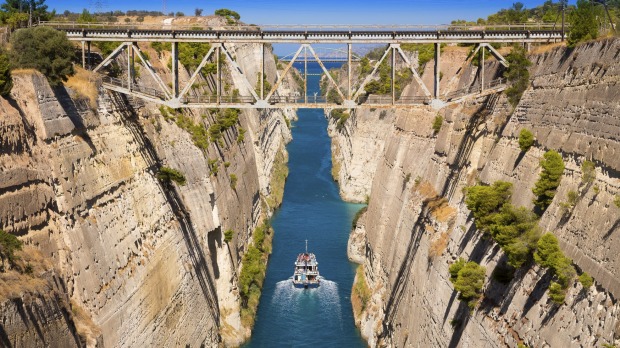
Claustrophobes beware. Entering the Corinth Canal is like being swallowed by the earth. And it doesn't help that Captain Etienne Garcia is looking a bit alarmed. The commander of the small luxury French cruise ship Le Soleal has spotted a rockfall ahead. High sandstone walls close in on us as we navigate the 21-metre-wide Corinth Canal in our 18-metre-wide ship. There's no room for error.
We're guests on the bridge as we slide past the errant rocks, which are not unusual in this narrowest of canals whose walls are prone to landslips. Everyone breathes more freely, but it's already a tight squeeze – the canal is impassable for most modern ships.
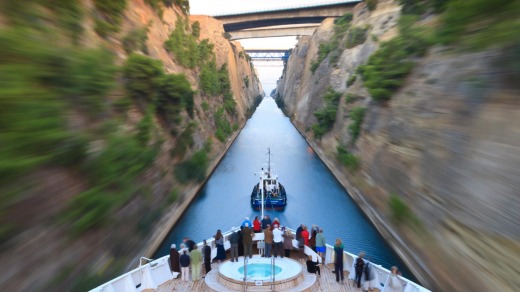
In fact, it's such a tight squeeze, two local Greek pilots have taken command, relegating the captain to the role of a somewhat anxious bystander. The canal links the Aegean's Saronic Gulf with the Adriatic's Gulf of Corinth, cutting through the land bridge that connects the Peloponnese with the Greek mainland.
It's the only place where captains must relinquish control. Now, one of the pilots has Captain Garcia's wheel, while the other runs from port to starboard calling instructions. Ships can hit the canal walls, usually because of steering or mechanical problems. To reduce this risk, the canal closes in bad weather.
But today has dawned clear, and passengers have responded to Captain Garcia's crack-of-dawn announcement to abandon our beds and come on deck to witness one of the highlights of our 17-day APT Ancient Mediterranean cruise.
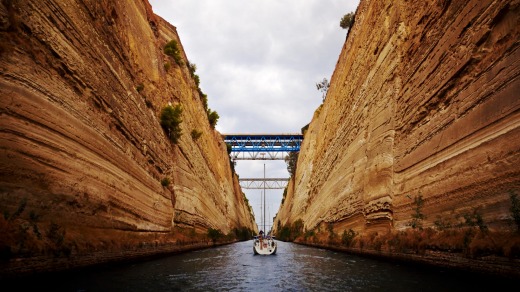
It's not to be missed. Even Captain Garcia has only sailed the canal five times.
Navigating the 6.4-kilometre long canal is a stunning experience, not just because you can almost touch the 79-metre-high canal walls, but also because their distinct sedimentary layers chart earth's history. To top it off, wall-dwelling eucalypts wave hello to passengers.
There's hot coffee and pastries in the forward Observation Bar as we lean on the rails, trying to spot the narrow canal entrance. An invitation to the bridge means a bird's eye view of the hour-long navigation.
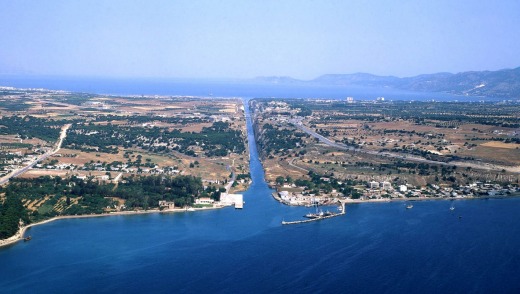
The Corinth Canal reinforces the absolute insignificance of those who transit. We are toy people, on a tiny ship at the bottom of a huge tin can, with a thin ribbon of blue sky above. The towering walls threaten to crush us.
Yet there's something magical about this feat of engineering whimsy that has sliced Greece apart, creating an island from a peninsula. But due to the canal's narrowness, plus landslip closures, traffic was disappointing. Perhaps it was doomed from the start.
Despite assassinations, superstition, bankruptcies, geological instability, many dreamed of a canal. Many failed. For 2000 years, rulers puzzled over how to slice 343 kilometres from the Peloponnesian route.
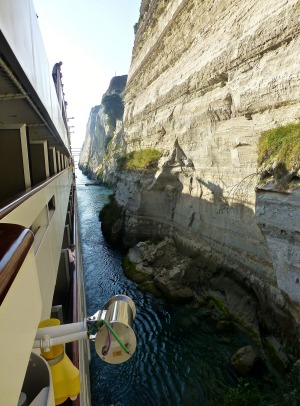
Naysayers like Greek philosopher Apollonius of Tyana prophesied a violent death for those who tried to join the gulfs. Sure enough, the three Roman rulers with canal plans – Julius Caesar, Caligula and Nero – did not go peacefully to their Elysian Fields. Nero actually started work himself with his little golden hoe (and 6000 slaves). It did him no good.
Perhaps Poseidon was to blame. The sea god apparently objected to joining the two seas. There were also fears that the Adriatic, thought to be higher, would flood the Aegean.
Keen to avoid murder and mayhem, Periander of Corinth shrewdly abandoned his canal plans in the 7th-century BC and built a cross-country stone carriageway, or Diolkos, so ships could be towed across land. Diolkos remnants are still visible today.
The modern canal was finally completed in 1893 and about seven ships a day transit, each paying €3500 ($5015). A number of bridges cross the canal, and in summer bungee jumpers can brave the wind-tunnel effect, occasionally "corkscrewing". What fun that must be.
There are high spirits as we pop from the canal into the glassy Gulf of Corinth, dolphins accompanying the ship beneath the snow-capped northern Peloponnesian ranges. Our transit has not triggered any plagues, fires or earthquakes. Greece remains the paradise of the gods, and the aroma of breakfast bacon is wafting from the sundeck.
aptouring.com.au
visitgreece.gr/en/destinations/korinthos
Emirates flies daily from Sydney, Melbourne and Brisbane to Venice, the starting point of the cruise, via Dubai, with return flights from Istanbul, where the cruise concludes, via Dubai. See emirates.com.
APT's 15-day Adriatic & Aegean Odyssey Boutique Collection all-inclusive small ship coastal cruise from Venice to Istanbul (includes Corinth Canal) aboard the MS Island Sky (departures in April, July and August 2016) is priced from $13,295 per person (includes APT's Early Payment Discount). Phone 1300 196 420 or see aptouring.com.au.